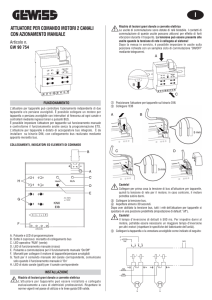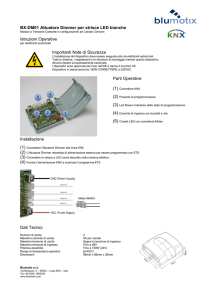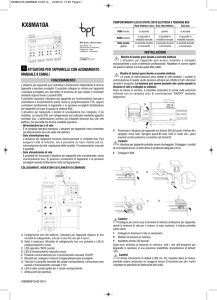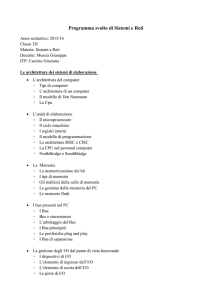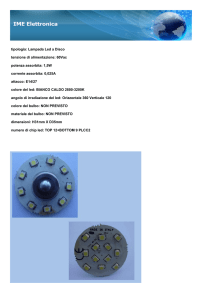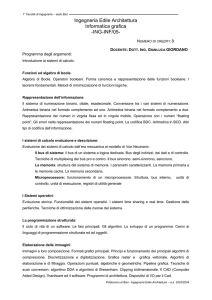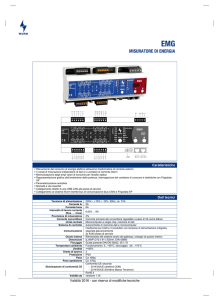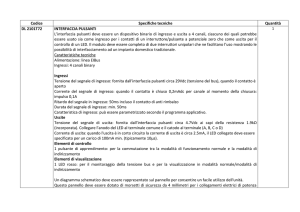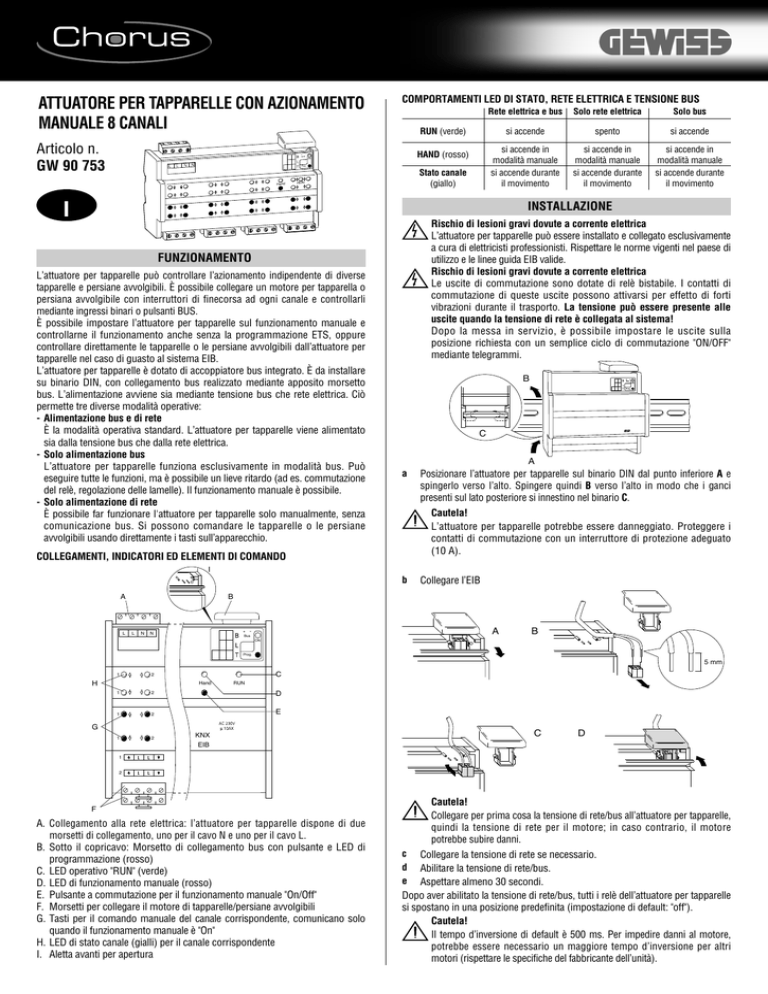
ATTUATORE PER TAPPARELLE CON AZIONAMENTO
MANUALE 8 CANALI
Articolo n.
GW 90 753
+ Bus
COMPORTAMENTI LED DI STATO, RETE ELETTRICA E TENSIONE BUS
Solo rete elettrica
Solo bus
si accende
spento
si accende
si accende in
modalità manuale
si accende durante
il movimento
si accende in
modalità manuale
si accende durante
il movimento
si accende in
modalità manuale
si accende durante
il movimento
RUN (verde)
HAND (rosso)
ON
Prog .
Hand
Rete elettrica e bus
Stato canale
(giallo)
RUN
I
INSTALLAZIONE
Rischio di lesioni gravi dovute a corrente elettrica
L’attuatore per tapparelle può essere installato e collegato esclusivamente
a cura di elettricisti professionisti. Rispettare le norme vigenti nel paese di
utilizzo e le linee guida EIB valide.
Rischio di lesioni gravi dovute a corrente elettrica
Le uscite di commutazione sono dotate di relè bistabile. I contatti di
commutazione di queste uscite possono attivarsi per effetto di forti
vibrazioni durante il trasporto. La tensione può essere presente alle
uscite quando la tensione di rete è collegata al sistema!
Dopo la messa in servizio, è possibile impostare le uscite sulla
posizione richiesta con un semplice ciclo di commutazione "ON/OFF"
mediante telegrammi.
FUNZIONAMENTO
L’attuatore per tapparelle può controllare l’azionamento indipendente di diverse
tapparelle e persiane avvolgibili. È possibile collegare un motore per tapparella o
persiana avvolgibile con interruttori di finecorsa ad ogni canale e controllarli
mediante ingressi binari o pulsanti BUS.
È possibile impostare l’attuatore per tapparelle sul funzionamento manuale e
controllarne il funzionamento anche senza la programmazione ETS, oppure
controllare direttamente le tapparelle o le persiane avvolgibili dall’attuatore per
tapparelle nel caso di guasto al sistema EIB.
L’attuatore per tapparelle è dotato di accoppiatore bus integrato. È da installare
su binario DIN, con collegamento bus realizzato mediante apposito morsetto
bus. L’alimentazione avviene sia mediante tensione bus che rete elettrica. Ciò
permette tre diverse modalità operative:
- Alimentazione bus e di rete
È la modalità operativa standard. L’attuatore per tapparelle viene alimentato
sia dalla tensione bus che dalla rete elettrica.
- Solo alimentazione bus
L’attuatore per tapparelle funziona esclusivamente in modalità bus. Può
eseguire tutte le funzioni, ma è possibile un lieve ritardo (ad es. commutazione
del relè, regolazione delle lamelle). Il funzionamento manuale è possibile.
- Solo alimentazione di rete
È possibile far funzionare l'attuatore per tapparelle solo manualmente, senza
comunicazione bus. Si possono comandare le tapparelle o le persiane
avvolgibili usando direttamente i tasti sull’apparecchio.
B
C
A
a
Posizionare l’attuatore per tapparelle sul binario DIN dal punto inferiore A e
spingerlo verso l’alto. Spingere quindi B verso l’alto in modo che i ganci
presenti sul lato posteriore si innestino nel binario C.
Cautela!
L’attuatore per tapparelle potrebbe essere danneggiato. Proteggere i
contatti di commutazione con un interruttore di protezione adeguato
(10 A).
COLLEGAMENTI, INDICATORI ED ELEMENTI DI COMANDO
I
b
A
L
Collegare l’EIB
B
L
N
A
+ Bus
N
B
ON
Prog.
5 mm
1
2
1
2
1
2
1
2
H
C
Hand
RUN
D
E
G
C
KNX
EIB
D
1
2
Cautela!
Collegare per prima cosa la tensione di rete/bus all’attuatore per tapparelle,
quindi la tensione di rete per il motore; in caso contrario, il motore
potrebbe subire danni.
F
A. Collegamento alla rete elettrica: l’attuatore per tapparelle dispone di due
morsetti di collegamento, uno per il cavo N e uno per il cavo L.
B. Sotto il copricavo: Morsetto di collegamento bus con pulsante e LED di
programmazione (rosso)
C. LED operativo "RUN" (verde)
D. LED di funzionamento manuale (rosso)
E. Pulsante a commutazione per il funzionamento manuale "On/Off"
F. Morsetti per collegare il motore di tapparelle/persiane avvolgibili
G. Tasti per il comando manuale del canale corrispondente, comunicano solo
quando il funzionamento manuale è "On"
H. LED di stato canale (gialli) per il canale corrispondente
I. Aletta avanti per apertura
c
d
e
Collegare la tensione di rete se necessario.
Abilitare la tensione di rete/bus.
Aspettare almeno 30 secondi.
Dopo aver abilitato la tensione di rete/bus, tutti i relè dell’attuatore per tapparelle
si spostano in una posizione predefinita (impostazione di default: "off").
Cautela!
Il tempo d’inversione di default è 500 ms. Per impedire danni al motore,
potrebbe essere necessario un maggiore tempo d’inversione per altri
motori (rispettare le specifiche del fabbricante dell’unità).
f
Collegare la tapparella o la veneziana avvolgibile come indicato di seguito:
N
L
BUS
10A
L
L
N
N
1
10A
1a
L
2
1b
2a
L
2b
10A
N
N
g
Attivare la tensione di rete per il motore.
È ora possibile controllare che l’attuatore per tapparelle e i motori collegati
funzionino senza dover caricare l’applicazione dall’ETS (vedere sezione
“Funzionamento”, “Come funziona la modalità manuale”).
FUNZIONAMENTO
Messa in servizio dell’attuatore per tapparelle
a Aprire l’aletta.
b Premere il pulsante di programmazione.
Il LED di programmazione rosso si accende.
c Caricare l’indirizzo fisico e l’applicazione nell’attuatore per tapparelle
dall’ETS. Il LED di programmazione rosso si spegne.
Dopo aver caricato con successo l’applicazione, l’attuatore per tapparelle è
pronto per il funzionamento e il LED operativo verde “RUN” si accende.
COME FUNZIONA LA MODALITÀ MANUALE
Le tapparelle o le veneziane avvolgibili si azionano normalmente tramite
pulsanti o telecomando. È comunque possibile commutare il funzionamento
dell’attuatore per tapparelle in modalità manuale per poi alzare o abbassare a
mano la tapparella usando gli appositi tasti sull’apparecchio.
A tale scopo, il parametro ETS “Modalità manuale abilitata” deve essere
impostato su “abilitato” e la tensione di rete/bus deve essere presente.
PRIMO FUNZIONAMENTO MANUALE PRIMA DI SCARICARE L’APPLICAZIONE
È possibile commutare l’attuatore per tapparelle in modalità manuale subito dopo
la prima installazione, ad esempio per testare i collegamenti delle tapparelle.
FUNZIONAMENTO MANUALE CON IMPOSTAZIONE ETS “FUNZIONAMENTO
MANUALE E BUS”
L’attuatore per tapparelle risponde ai telegrammi EIB anche in modalità manuale. La
priorità viene data all’ultimo comando ricevuto. Eccezione: gli allarmi di sicurezza
(ad es. fenomeni atmosferici) hanno sempre la priorità con questa impostazione.
FUNZIONAMENTO MANUALE CON IMPOSTAZIONE ETS “SOLO
FUNZIONAMENTO MANUALE”
In modalità manuale, l’attuatore per tapparelle non risponde né ai telegrammi
EIB né agli allarmi di sicurezza! Questa impostazione può rivelarsi utile durante
l’esecuzione di interventi di manutenzione.
Cautela! Quando si azionano le tapparelle o le veneziane avvolgibili in
modalità “Solo funzionamento manuale” tramite i tasti sull’apparecchio,
le funzioni di sicurezza quali “posizione allarme fenomeni atmosferici”,
“posizione allarme”, “posizione disabilitazione” o il range di corsa non
funzionano più. Per evitare danni all’attuatore per tapparelle/veneziane
avvolgibili si consiglia di prestare la massima attenzione durante il
funzionamento manuale!
Nota: Accertarsi che il parametro ETS "Funzionamento manuale" sia
impostato su "Funzionamento bus e manuale" (non "Solo funzionamento
manuale") quando si consegna il sistema all’utente.
Un’altra funzione impostabile nell’ETS è il funzionamento manuale temporizzato.
Questa funzione permette di impostare un periodo di tempo al termine del quale
il funzionamento manuale (compreso “Solo funzionamento manuale”) viene
automaticamente disabilitato. L’attuatore per tapparelle ricomincia quindi a
rispondere ai telegrammi EIB.
COME IMPOSTARE L’ATTUATORE PER TAPPARELLE SUL FUNZIONAMENTO
MANUALE
a Premere il pulsante a commutazione “HAND”
Il LED “HAND” rosso si accende. L’attuatore per tapparelle funziona in modalità
manuale. Il LED operativo "RUN" verde si spegne quando viene impostata la
modalità "Solo funzionamento manuale” nell’ETS.
Il LED operativo "RUN" verde resta acceso quando si imposta la modalità
"Funzionamento bus e manuale” nell’ETS.
COME TERMINARE IL FUNZIONAMENTO MANUALE
a Premere di nuovo il pulsante “HAND”
Il LED D rosso si spegne. Il LED operativo "RUN" verde si accende. Ora
l’attuatore per tapparelle risponde solo ai telegrammi EIB.
COME COMANDARE LE TAPPARELLE/VENEZIANE AVVOLGIBILI IN
MODALITÀ MANUALE
a Per sollevare (freccia verso l’alto) o abbassare (freccia verso il basso) la
tapparella o la veneziana avvolgibile: Premere il corrispondente tasto.
b Per interrompere: Premere di nuovo il tasto.
Il corrispondente LED di stato si accende durante il movimento.
COSA FARE IN CASO DI PROBLEMI?
Il LED di funzionamento “HAND” rosso e il LED operativo “RUN” verde non si
accendono. Non è possibile attivare il funzionamento manuale.
Manca la tensione di rete/bus. Controllarle entrambe.
Il LED operativo "RUN" verde non si accende.
Manca la tensione bus. Controllare la tensione bus; è possibile solo il
funzionamento manuale. L’applicazione non è stata caricata correttamente.
Ripetere il caricamento. Il LED “HAND” rosso è acceso: Il funzionamento
manuale è attivo e nell’ETS è impostato il parametro “Solo funzionamento
manuale”. È possibile solo il funzionamento manuale. Non ci sono anomalie.
Disattivare il funzionamento manuale.
L’attuatore per tapparelle non risponde al pulsante “HAND”. Il LED “HAND”
rosso non è acceso. Non è possibile il funzionamento manuale.
Il parametro ETS "Funzionamento manuale abilitato" non è abilitato. Non ci
sono anomalie. Impostare il parametro “Funzionamento manuale abilitato”.
L’attivazione del funzionamento manuale è bloccata da un oggetto (valore = “0”).
Non ci sono anomalie. Funzionamento manuale abilitato dall’oggetto.
Con il funzionamento manuale, l’attuatore per tapparelle non risponde alla
pressione dei tasti canali; il LED “HAND” rosso è acceso; non è possibile il
funzionamento manuale.
Il LED operativo "RUN" verde è ancora acceso: Il parametro ETS
“Funzionamento manuale” è impostato su “Funzionamento bus e manuale”. È
attiva una funzione di livello superiore (ad es. allarme o blocco per fenomeni
atmosferici). Non ci sono anomalie. Attendere la conclusione della funzione di
livello superiore oppure commutare il parametro ETS da “Funzionamento
manuale” a “Solo funzionamento manuale”. Rispettare la nota di sicurezza nel
paragrafo “Come funziona la modalità manuale”! Il LED operativo "RUN" verde
non è acceso: Manca la tensione bus e il parametro ETS “Funzionamento
manuale in mancanza di tensione bus” è stato disabilitato. Controllare la
tensione bus.
Con il funzionamento manuale, l’attuatore per tapparelle controlla i motori
collegati senza che venga premuto alcun tasto canale.
Il parametro ETS “Funzionamento manuale” è impostato su “Funzionamento
bus e manuale”. Il comando di controllo per l’attuatore per tapparelle è arrivato
tramite telegramma EIB. Non ci sono anomalie. Commutare il parametro ETS
da “Funzionamento manuale” a “Solo funzionamento manuale”. Rispettare la
nota di sicurezza nel paragrafo “Come funziona la modalità manuale”!
DATI TECNICI
Tensione ausiliaria esterna: AC 110-240 V, 50-60 Hz, max. 2 VA
Alimentazione da EIB: CC 24 V, max. 17,5 mA
Tensione di isolamento: 4 kV CA tra bus e uscite di commutazione
Tensione nominale: AC 230 V
Corrente nominale: 10 A, carico induttivo cos ϕ = 0,6
Potenza nominale del motore: max. 1000 W a AC 230 V
Frequenza di commutazione: max. 15x al minuto con carico nominale
Temperatura ambiente
- Funzionamento: da -5 a +45 °C
- Conservazione: da -25 a +55 °C
- Trasporto: da -25 a +70 °C
Ambiente: può essere utilizzato fino a 2000 m sopra il livello del mare (SLM)
Umidità max.: 93%, senza condensa di umidità
Elementi operativi:
- 1 pulsante di programmazione
- 1 pulsante a commutazione “HAND” per il funzionamento manuale
- 2 tasti per ogni canale
Elementi per la visualizzazione:
- 1 LED rosso: Comando di programmazione
- 1 LED verde: pronto per il funzionamento, "RUN"
- 1 LED rosso: Stato funzionamento manuale
- 2 LED di stato gialli per canale
Collegamento EIB: due piedini da 1 mm per il morsetto di collegamento bus
Collegamento di rete: morsetti a vite x4 per max. 2,5 mm2 2 x L / 2 x N
Collegamento cavo esterno: per canale un morsetto a vite x4 inseribile per
max. 2,5 mm2
IMPOSTAZIONI NEL SOFTWARE EIB (ETS)
L’applicazione è compatibile con ETS 3. Per garantire la piena funzionalità
delle applicazioni con ETS2, è necessario utilizzare ETS2 versione 1.2 o
superiore e Service Release A o superiore. Per qualsiasi domanda,
contattare l’infoline di Gewiss.
BLIND ACTUATOR WITH MANUAL ACTUATION
8x230V
RELATIONSHIP BETWEEN STATUS LEDS AND MAINS AND BUS VOLTAGE
Mains and bus
Mains only
Bus only
lights up
off
lights up
RUN (green)
Article n.
GW 90 753
+ Bus
ON
lights up on manual lights up on manual lights up on manual
operation
operation
operation
lights up when
lights up when
lights up when
in motion
in motion
in motion
MANUAL (red)
Prog .
Hand
Channel status
(yellow)
RUN
INSTALLATION
GB
Risk of fatal injury from electric current
The blind actuator may only be installed and connected by professional
electricians. Observe the regulations valid in the country of use, as well
as the valid EIB guidelines.
Risk of fatal injury from electric current
The switch outputs have a bistable relay. The switch contacts of these
outputs can be changed to the enabled state due to strong vibrations
during transportation. Voltage may be present at the outputs when the
mains voltage is connected to the system!
After commissioning, you can set the outputs to the required position
with a simple "ON/OFF" switching cycle using telegrams.
FUNCTION
When used with BUS EIB, the blind actuator can control several blind and roller
shutter drives independently of one another. You can connect one blind or
roller shutter motor with end position switches to each channel, and control
these with BUS push-buttons or binary inputs.
You can switch the blind actuator to manual operation and check that it works
even without ETS programming, or control the connected blinds or roller
shutters directly at the blind actuator in the event of an EIB failure.
The blind actuator has an integrated bus coupler. It is installed on a DIN rail,
with the bus connection made via a bus connecting terminal. It is supplied with
power both from the bus voltage and from the mains. This makes three
different operating modes possible:
- Bus and mains supply
This is the standard operating mode. The blind actuator is supplied by both
the bus and mains voltages.
- Bus supply only
The blind actuator is pure bus mode. It can carry out all functions, but there
may be a slight time delay (e.g. switching of the relays, slat adjustment).
Manual operation is possible.
- Mains supply only
It may only be possible to operate the blind actuator manually, without bus
communication. You can operate the blind or roller shutter directly using the
channel keys.
B
C
A
a
Caution!
The blind actuator could be damaged. Protect the switch contacts with a
series-connected 10 A circuit breaker:
- Switching contacts with a series-connected 10 A circuit breaker
- If the mains voltage is looped, protect the mains connection with a
series-connected 10 A circuit breaker also.
CONNECTIONS, DISPLAYS AND OPERATING ELEMENTS
I
A
L
B
L
N
b
+ Bus
N
Place the blind actuator on the DIN rail from underneath A and push it
upwards. Then press up B so that the claws on the rear side fix into the rail C.
Connect EIB
A
ON
B
Prog.
5 mm
1
2
1
2
1
2
1
2
H
C
Hand
RUN
D
E
G
KNX
EIB
C
D
1
2
F
A. Mains connection: The blind actuator has two connecting terminals each for
the N and L cables (looping is possible).
B. Under the cable cover: Bus connecting terminal with programming button
and programming LED (red)
C. Operating LED "RUN" (green)
D. Manual operation LED (red)
E. Toggle key for manual operation "On/Off"
F. Channel terminals for blind/roller shutter motor connection
G. Channel keys for manual control of the corresponding channel; only
communicate when manual operation is "On"
H. Channel status LEDs (yellow) for the corresponding channel
I. Flap forward to open
Caution!
Connect the bus/mains voltage to the blind actuator first and only then the
mains voltage for the motor; otherwise, the motor could be damaged.
c Connect mains voltage if necessary.
d Switch on bus/mains voltage.
e Wait at least 30 seconds.
After the bus/mains voltage has been switched on, all the blind actuator relays
are moved to a predefined position (default setting: "Off").
Caution!
The default reversing time on delivery is 500 ms. To prevent damaging
the motor, a longer reserving time may be necessary for other motors
(observe the specifications of the drive manufacturer).
a
N
L
BUS
10A
L
N
L
N
1
10A
1a
L
2
1b
2a
L
WHAT SHOULD I DO IF THERE IS A PROBLEM?
The red manual operation LED "Manual" and the green operating LED "RUN"
are not lit. Manual operation cannot be activated.
Bus and mains voltage have failed. Check both.
The green operating LED "RUN" is not lit.
The bus voltage has failed. Check bus voltage; only manual operation is
possible. Application was not loaded properly. Load it again.
Red "Manual" LED is lit: Manual operation is active and "Manual operation only"
is set in the ETS. Only manual operation is possible. There is no malfunction.
Switch off manual operation.
Blind actuator does not respond to the "Manual" toggle switch. The red
"Manual" LED is not lit. Manual operation is not possible.
ETS parameter "Manual operation enabled" is not enabled. There is no
malfunction. Set the "Manual operation enabled" parameter.
Manual operation activation is blocked by an object (value = "0"). There is no
malfunction. Manual operation enabled by object.
In manual operation, the blind actuator does not respond to the channel keys
being pressed; the red "Manual" LED is lit; manual mode is not possible.
The green operational LED "RUN" is still lit: ETS parameter "Manual operation
type" is set to "Bus and manual operation". A higher-level function (e.g. weather
alarm or lock) is active. There is no malfunction.
Wait until the higher-level function has been completed, or switch the ETS
parameter "Manualoperation type" to "Manual operation only". Observe the
safety note in the section "How manual operation works"!
The green operating LED "RUN" is not lit: Bus voltage has failed and the ETS
parameter "Manual operation when bus voltage fails" has been disabled. Check
bus voltage.
In manual operation, the blind actuator controls connected motors without a
channel key being pressed.
ETS parameter "Manual operation type" is set to "Bus and manual operation".
The control command for the blind actuator came via an EIB telegram.
There is no malfunction. Switch the ETS parameter "Manual operation type"
to "Manual operation only". Observe the safety note in the section "How
manual operation works"!
2b
10A
N
N
g
Switch on the mains voltage for the motor.
Now you can check that the blind actuator and connected motors work without
having to load the application from the ETS (see section "Operation", "How
manual operation works").
OPERATION
Commissioning the blind actuator
a Open the flap.
b Press the programming button.
The red programming LED lights up.
c Load the physical address and application into the blind actuator from the
ETS. The red programming LED goes out.
When the application has been loaded successfully and the blind actuator is
ready for operation, the green operating LED "RUN" lights up.
HOW MANUAL OPERATION WORKS
Normally, you control the blind or roller shutter using push-buttons or by
remote control. However, you can also switch the blind actuator to manual
operation and then raise or lower each blind manually using its channel keys.
In order to be able to do this, the ETS parameter "Manual operation enabled"
must be set to "enabled" and mains or bus voltage must be present.
MANUAL OPERATION BEFORE DOWNLOADING THE APPLICATION FOR THE
FIRST TIME
You can switch the blind actuator to manual operation immediately after initial
installation, e.g. in order to test the connections of the blinds.
TECHNICAL DATA
External auxiliary voltage: AC 110–240 V, 50–60 Hz, max. 2 VA
Supply from EIB: DC 24 V, max. 17.5 mA
Insulation voltage: 4 kV AC between bus and switch outputs
Nominal voltage: AC 230 V
Nominal current: 10 A, inductive load cos ϕ = 0.6
Nominal power of motor: max. 1000 W at AC 230 V
Switching frequency: max. 15x per minute at nominal load
Ambient temperature
- Operation: -5 to +45 °C
- Storage: -25 to +55 °C
- Transport: -25 to +70 °C
Environment: can be used at up to 2000 m above sea level (MSL)
Max. humidity: 93%, no moisture condensation
Operating elements:
- 1 programming button
- 1 "Manual" toggle switch for manual operation
- 2 channel keys per channel
Display elements:
- 1 red LED: Programming control
- 1 green LED: ready for operation, "RUN"
- 1 red LED: Manual operation status
- 2 yellow status LEDs per channel
EIB connection: two 1 mm pins for bus connecting terminal
Mains connection: 4-gang screw terminals for max. 2.5 mm2 2 x L / 2 x N
External cable connection: per channel one plug-in 4-gang screw terminal for
max. 2.5mm2
MANUAL OPERATION WITH THE ETS SETTING "BUS AND MANUAL OPERATION"
In manual operation, the blind actuator also responds to EIB telegrams. The
command last received is given priority. Exception: Safety alarms (e.g.
weather) always have priority with this setting.
MANUAL OPERATION WITH THE ETS SETTING "MANUAL OPERATION ONLY"
In manual operation, the blind actuator does not respond to EIB telegrams, nor
to safety alarms! This setting can be useful when carrying out maintenance, for
example.
Caution! When operating blinds or roller shutters in "Manual operation
only" using the channel keys, safety functions such as weather alarm
position, alarm position, disable position or travel range no longer work.
To prevent damage to the blind/roller shutter, you should therefore be
very careful when operating manually!
Note: Make sure that the ETS parameter "Manual operation type" is set
to "Bus and manual operation" (not "Manual operation only") when you
hand over the system to the operator.
Time-limited manual operation is another function that can be set in the ETS.
With this function, you can set a time period after which manual operation
(including "Manual operation only") is cancelled automatically.
The blind actuator then responds to EIB telegrams again.
HOW TO SET THE BLIND ACTUATOR TO MANUAL OPERATION
a Press the toggle switch for "manual operation"
The red "Manual operation" LED lights up. The blind actuator is in manual
operation. The green operating LED "RUN" goes out when "Manual operation
only" is set in the ETS.
The green operating LED "RUN" remains lit when "Bus and manual operation" is
set in the ETS.
SETTINGS IN THE EIB TOOL SOFTWARE (ETS)
The application is ETS 3 compatible.
To guarantee the full functionality of the applications under ETS2, ETS2
version 1.2 or higher and Service Release A or higher should be used. If
you have any queries, contact the Gewiss infoline.
HOW TO END MANUAL OPERATION
a Press the toggle switch for "manual operation" again.
The red LED D goes out. The green operating LED "RUN" lights up. The blind
actuator now only responds to EIB telegrams.
Ai sensi dell’articolo 9 comma 2 della Direttiva Europea 2004/108/CE e dell’articolo R2 comma 6 della Decisione 768/2008/CE si informa che responsabile dell’immissione del prodotto sul mercato Comunitario è:
According to article 9 paragraph 2 of the European Directive 2004/108/EC and to article R2 paragraph 6 of the Decision 768/2008/EC, the responsible for placing the apparatus on the Community market is:
GEWISS S.p.A Via A. Volta, 1 - 24069 Cenate Sotto (BG) Italy Tel: +39 035 946 111 Fax: +39 035 945 270 E-mail: [email protected]
+39 035 946 111
8.30 - 12.30 / 14.00 - 18.00
lunedì ÷ venerdì - monday ÷ friday
Cod. 7.01.0.859.2
HOW TO CONTROL THE BLIND/ROLLER SHUTTER IN MANUAL OPERATION
To raise (arrow up) or lower (arrow down) the blind or roller shutter:
Press the corresponding channel key.
b To halt: Press the channel key again.
The corresponding channel status LED lights up during movement.
Connect the blind or roller shutter as shown below:
+39 035 946 260
24h
[email protected]
www.gewiss.com
ULTIMA REVISIONE 02/2011
f

